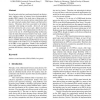Free Online Productivity Tools
i2Speak
i2Symbol
i2OCR
iTex2Img
iWeb2Print
iWeb2Shot
i2Type
iPdf2Split
iPdf2Merge
i2Bopomofo
i2Arabic
i2Style
i2Image
i2PDF
iLatex2Rtf
Sci2ools
AIA
2006
2006
FPGA-Targeted Neural Architecture for Embedded Alertness Detection
Several recent works have used neural networks to discriminate vigilance states in humans from electroencephalographic (EEG) signals. Our study aims at being more exhaustive. It takes into account various connectionist models, and it precisely studies their features and their performances. Physicians have been associated to the project, especially when tuning our models. Above all, our work has been oriented in such a way to get a light, low-power, easy to wear system. First implementation works have focused on the use of a Self-Organizing Map architecture, since the most efficient neural model of our study, a multilayer perceptron (MLP), was too huge for a straightforward FPGA implementation. In this paper, we describe how the theory of FPNA (Field Programmable Neural Arrays) has been applied to this model, so as to simplify the topology of the MLP of our application. Thanks to this simplification, a fully parallel FPGA implementation has been made possible and efficient, without any...
| Added | 30 Oct 2010 |
| Updated | 30 Oct 2010 |
| Type | Conference |
| Year | 2006 |
| Where | AIA |
| Authors | Bernard Girau, Khaled Ben Khalifa |
Comments (0)

